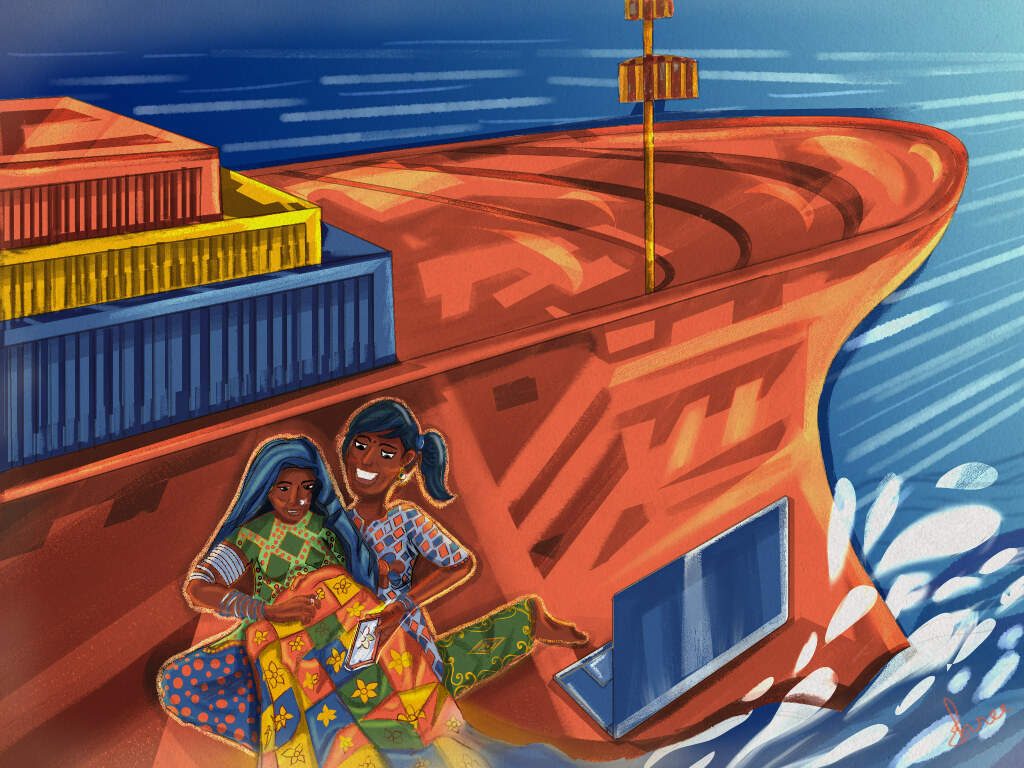A promising journey: India’s tryst with digitalization
Shovontika studied at the St Xaviers College, Kolkata.
The biggest part of our digital transformation is changing the way we think
Simon Preston Bupa
As the Indian economy slowly draws away the dark shroud of the virus, one cannot help but look back at one of the key pillars that helped treat the wounds of the pandemic: digitization. Digitization or the digital revolution, which began almost a decade ago, is now a global phenomenon to be reckoned with. Fostering connectivity for over 1.4 billion[I] in the nation, and beyond- the digital realm is a success story of its own. While on one hand the country seeks to better its dented image on several global indicators (including hunger, corruption, crime and bribery), digital empowerment provides an altogether separate albeit commendable reason for some optimism. This article traces the humongous growth of digitalization in India, further continuing with its implications and impacts on foreign policy and lastly analyses the promise that it holds for enhancing the country’s soft power and global image.
With the country completing 75 years of independence, there are enough reasons to count the milestones achieved by this fledgling, emerging world power. Noteworthy among these is the high tide of digitization, with its immense prospective in revolutionizing politico-economic face of the nation, by simplifying policy decisions, amplifying interconnectivity and accessibility. Technology, for the past two decades, has been a ubiquitous part of citizens’ lives, intrinsically intermingling with their daily schedules. This makes the sector an arena of pre-eminence, since it carries within it the potential to ensure that the developing economy gains recognition on global forums.
Digital India, Demonetization and COVID
India’s tryst with digitalization gained pace after demonetization, when widespread panic and cash crunch was juxtaposed with a decrease in withdrawals from Automatic Teller Machines (ATMs). It equally boosted the adoption of digital means of payment. Indeed, the country’s unparalleled success with regard to open digital ecosystems, such as Aadhar, UPI (Unified Payments Interface), Co-Win and Jan Dhan drew global attention. Technological advancement occupies the center-stage in domestic policy for almost a decade now, owing to Prime Minister Narendra Modi’s commitment to the Digital India scheme. Launched in 2015, the latter is a flagship programme of the Government of India, which aims to digitally empower the country’s teeming millions. The campaign has indeed converted India into a digitally empowered State, with enhanced online infrastructure and extended internet connectivity- which has in turn boosted productivity and eased the lives of citizens. In a country with a literacy rate of 77.7 %, wherein a sizeable section of the populace remains semi-literate or illiterate, sources identify around 200 million smartphone users in 2019. This exemplary feat alone justifies the profound impact that digitalization has had on the Indian society.
The Indian experiment with digitalization emerged triumphant in the face of the Covid-19 scare- which stagnated life for almost a year and half. As businesses endorsed in widespread retrenchment and citizens quarantined themselves inside their homes, technology came as a messiah in a lifeless India. Barring essential services such as healthcare units, water, electricity and food supply chains, medical stores and police stations, shops and markets shut down -resulting in the proliferation of a host of online services. Indeed, the digital revolution reached its peak of success during the pandemic, owing to citizen dependency and handicap. The boon of digitalization enabled continued education and assessments via a plethora of applications and transformed work culture in general.
Digitalization proves to be an astounding initiative, which carried within it the potential to pull the Indian economy out of the ravages of the pandemic. The impediments of the SAARC-CoV 2 virus imprinted fear on the minds of the populace, resulting in changing consumer behavior. Digital marketing thus cropped up with enhanced methods for customer engagement using AI (Artificial Intelligence) service portals, gaining customer confidence and trust. The Indian government has rightly capitalized on this lucrative opportunity, with the creation and seamless functioning of online portals for almost all sorts of governmental services. The availability of a host of such services – right from ones aiding citizens’ identification to taxation goes a long way in aiding centralization and enhancing state control on essential services. The 5G network’s vision ‘Internet for all’, carries within it the government’s agenda to bridge the digital divide, and popularize technology as the catalyst to success essential for all sections of the society. Indeed, as pointed out by Prime Minister Narendra Modi at the National Technology and Futuristic Forum organized by NASSCOM, “digitization has brought the citizens closer to the government.[6] Technology also goes a long way in abbreviating the menace of corruption, with greater transparency available on the procurement and tendering process for various infrastructural and developmental projects.
Digitization further envisions to revolutionize agriculture, with a transition from age-old laborious means of farm production to the usage of drones, robotics, uncrewed aviation systems, sensors and communication networks- for mapping surface area, assessing soil type and devising resource efficient farming techniques. In a prismatic society with heavy dependency on the agrarian sector, technological reforms are a necessity for the country’s ever-growing population (now standing at 1.4 billion).
Digital soft power
Digitization also holds great prospects in revamping the face of diplomacy, an integral ingredient of Indian foreign policy. The latter refers to the conduct of relations by means of negotiation and communication between states and other international actors.
The transition from public diplomacy to digital diplomacy holds great prospect for strengthening the hegemon’s soft power. The revolution brought in by social media pioneered the apt and the precise use of technology, to engage with the public on large scale. With diplomacy being at the core of geo-politics in the contemporary world, India is expected to use digitization as a tool to forward its national interests and create a brand name for itself on the global front. Cybersecurity, challenges cropping up due to cross-border terrorism, international peace and discriminatory trade practices are some of the emerging unconventional concerns in the globalized, interconnected world of the 21st century.
Contemporary problems require novel solutions- hence the use of digitization for online diplomacy. As a strategic regional power aiming to counterbalance the Chinese influence in South Asia, India must gear up and systematically use available resources for socio-cultural diplomacy, dominance and assertion. India’s Look East policy, introduced in the 1990s has evolved into the Act East Policy, with digital diplomacy ensuring faster consular outreach in its neighboring nations, to whom the country had pledged humanitarian aid during the Covid crisis.
The MADAD scheme, an innovation of the Ministry of External Affairs in 2015, was launched with an aim to improve and escalate the tracking of unresolved cases pertaining to the Indian diaspora [5]. Twitter too, has emerged as platform encouraging the expression of radical views, with short messages, hashtags and catchy captions, drawing increased attention to immediate socio-political, or even psychological concerns. A barrage of opinions find expression on these virtual platforms, enabling a coalesce of ideas and the circulation of popular ideologies. Negative narratives and demeaning imagery could thus be strategically used by foreign diplomats of enemy nations, as has been prevalent with a growing increase in cybercrimes. Since digital diplomacy involves direct engagement with the citizens- India must use the same with utmost care. Regulation of cross- border data flows and efficient e-Governance will make India a lucrative partner for a host of Tech firms, thereby providing it a stronghold on the world forum.
Indeed, the structural reformation of the country’s economy makes it ‘a bright spot on the otherwise dark global horizon’ [2]. The optimism brought in by digitization, alongside the relaxation of pandemic- based restrictions, have outweighed the rippling effects of geopolitical and global concerns. While regulations on cryptocurrency and focused attention on cross-border payments remain contentious issues, India’s current endeavor in the arena of digitization is to leave a lasting imprint on its economy for the years to come. Further developments in the sectors of energy transitions, especially renewable energy and enhanced connectivity with regard to the rural-urban interface will be add-ons to India’s soft power in the digital realm.
References
- Meyers, J. (2022, August). These will be the world’s most populous countries by 2030. Retrieved February 3, 2025, from https://www.weforum.org/agenda/2022/08/world-population-countries-india-china-2030
- Online, E. (2022, October 13). India is the bright spot on the dark global horizon: IMF MD Kristalina Georgieva. Retrieved May 25, 2025 from The Economic Times https://economictimes.indiatimes.com/news/economy/indicators/india-is-the-bright-spot-on-the-dark-global-horizon-imf-md-kristalina-georgieva/articleshow/94842867.cms
- Roy, S. (2021, March 22). India edges closer to the digitization of diplomacy. Retrieved May 25, 2025 from The Koot Neeti https://thekootneeti.in/2021/03/22/india-edges-closer-to-the-digitization-of-diplomacy/
- Jha, M. K., & Guest. (2022, July 11). Digital Diplomacy: Game of Codes in Geo-Politics. Retrieved May 25, 2025 from Financial Express https://www.financialexpress.com/defence/digital-diplomacy-game-of-codes-in-geo-politics/2589644/
- Government launches portal ‘MADAD’ to redress consular grievances. (2015, February). Retrieved May 25, 2025 from The Economic Times https://www.financialexpress.com/defence/digital-diplomacy-game-of-codes-in-geo-politics/2589644/
- Digital transactions helped reduce corruptions : PM Modi at NASSCOMM event. (2021, February 17). Retrieved May 25, 2025 from The Hindustan Times https://www.financialexpress.com/defence/digital-diplomacy-game-of-codes-in-geo-politics/2589644/
- Gupta, A. (2022, March 12). Digitization has transformed India’s governance model. The Economic Times. https://government.economictimes.indiatimes.com/news/digital-india/digitisation-has-transformed-indias-governance-model/90161883
- Fluellite, C., Guerin, I., & Servet, J.-M. (2021, March). Demonetization and digitalization: The Indian government’s hidden agenda. Retrieved May 25, 2025 from https://www.researchgate.net/publication/347889714_Demonetization_and_digitalization_The_Indian_government’s_hidden_agenda
- Dani, R. (2022, September 24). Digital India is a global success story. Times of India Blog. https://timesofindia.indiatimes.com/blogs/thedanispost/digital-india-is-a-global-success-story/
- The Indian expertise that can be a major form of foreign aid and soft power. (2022, August 30). The Economic Times. https://economictimes.indiatimes.com/opinion/et-commentary/the-indian-expertise-that-can-be-a-major-form-of-foreign-aid-and-soft-power/articleshow/93887871.cms
- Gupta, A. (2022, March 12). Digitization has transformed India’s governance model. The Economic Times. https://government.economictimes.indiatimes.com/news/digital-india/digitisation-has-transformed-indias-governance-model/90161883






